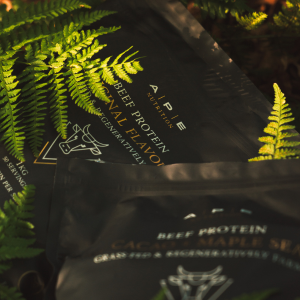A Nose-to-Tail Diet: The Most Nutrient Dense Approach to Eating

“Just remember that you're doing it for your health. You're doing it for respecting the animal and the earth.”
- The Paleo View Podcast
Nose-to-tail eating is a nutritional philosophy that involves eating every part of an animal, horns to hooves. As human beings we evolved eating this way and it’s what our bodies require for optimal health and vitality. Simply put, it’s a way of eating that includes organs, bones, connective tissue, skin and fat as well as the standard muscle meat. By following this approach, you will maximise your nutritional intake, providing your body with the raw materials to function to its highest potential.
Eating like this shows ultimate respect for the animal, which has given up its life so you can survive and thrive, because it lets nothing go to waste. For this same reason, it’s a very economical way of eating as by using ‘leftovers’ like bones to make broth, this makes your food go a lot further. Also, if the meat is sourced from regenerative farms (which we highly encourage), these have the highest standards for animal welfare and have been shown to positively impact the environment in a variety of ways.
In the sections below, I’ll dive into how eating nose-to-tail can drastically improve health, thus helping mitigate some of the chronic health issues the western world is experiencing today. I'll also discuss all of the above points in detail, including micronutrient bioavailability and anti-nutrients.

“We were told to cut fat, increase ‘complex carbs’, and all would be well. That is true if you're in the business of coronary artery bypass, statins, diabetes meds or gastric bypass.”
- Rob Wolf
Overfed but Undernourished
As a world population we’re generally overfed but undernourished. So much so that it’s widely accepted that we have an obesity epidemic, especially in Western societies. At the time of writing this, there are 817,691,727 people diagnosed as obese in the world, with this number increasing every second. I appreciate the criteria for defining obesity may not be entirely accurate, but even if the real numbers are half of what’s outlined here, it’s not a good place to be. There’s many compounding factors that have led to this sad state of affairs:
- As Rob Wolff outlines in his book ‘Wired to Eat’, our hunter gatherer programming doesn’t mesh well with the reality of modern day food availability. For the majority of human existence we would have had little access to foods high in sugar.* Once in a blue moon our ancestors may have stumbled across a beehive containing honey. In an instance such as this, they would have likely consumed as much as possible because they didn’t know when they would get an opportunity like it again. Fast forward to today and our brains are still wired this way. I’m sure everyone can relate to how easy it is to eat a whole packet of Oreos or a box of chocolates. However, for the first time in human history we have the ability to eat like this as frequently as we like and a lot of people are doing just that to the detriment of their health and long term happiness.
- Big food marketing campaigns, shiny packaging and even the way shops are laid out (with self checkout queues lined with shelves of chocolate bars) really don’t help the situation. Basically, we’re programmed from a very early age to over-consume and indulge when it comes to food.
- An extremely poor understanding of nutrition and misinformation pushed by ‘health authorities’ massively compounds the issue. The NHS website literally states that ’starchy food should make up just over a third of the food we eat’ with the associated image containing potatoes, bread, bagels, cereal, pasta and rice. It goes on to suggest eating unsaturated fats such as vegetable, rapeseed and sunflower oil. These chemically processed oils reak havoc in the body, causing systemic inflammation, depressing the immune system and causing metabolic dysfunction amongst other negative effects.
- Food scientists have a great understanding of how the human brain works when it comes to food. They know the exact combination of salt and sweet required to make the new crisps or chocolate their developing hyper palatable and addictive. They purposefully leave out micronutrients from these processed foods because they know these are what our bodies are looking for when we’re hungry. When consumed, micronutrients signal to our body that we’ve been fed and this brings eating to a natural conclusion. Leave these out and our ability to keep consuming can go on much longer.
As you can see, the odds are stacked against us when it comes to eating a healthy diet in the modern world. However, adopting a nose-to-tail diet, provides an antidote to a food system that’s got it very wrong.
*It’s well documented that native fruit was much lower in sugar than what occupies supermarket shelves today.

Our genome has evolved with the nourishment of nose-to-tail dining since the beginning of time. Grass fed beef organs are especially rich in preformed vitamin A, vitamin B12, coenzyme Q10, bio-available heme iron, selenium and enzymes. The health and happiness effects of consuming beef organs are far reaching. Beef organs (i.e. liver, heart, kidney, pancreas, spleen) strengthen and support the corresponding organ of the individual for improved immune function, robust collagen, improved energy to name a few.
- Brian Johnson
Grass-Fed Organ Meat: The Solution
For me, including grass-fed organ meat is a massive key to solving a lot of the problems created by our modern food system. Firstly it's a really high quality source of protein that’s packed with bioavailable micronutrients. Per gram of food consumed, organs yield the maximum nutrients for the minimum calories. We’re brought up to associate micronutrients with fruit and vegetables, however when it comes to nutrient variety and density, organ meat, especially liver is in a league of its own. To exemplify this fact, I reached out to our audience and asked people to name some ‘superfoods’. Three of the top answers (that weren’t organ meat), were brazil nuts, blueberries and kale. The table to the left puts these side by side with liver so you can see my point.
As you can see, although these ’superfoods’ may contain high amounts of certain nutrients, liver has a wider variety and density of micronutrients than all of them combined. Also, because liver is a source of protein, it contains 4 calories per gram, which is the same as carbohydrates (blueberries and kale), however fat sources like brazil nuts contain 9 calories per gram. It's worth noting that this table (like nutritional labels on food) doesn’t take bioavailability into consideration (the amount of nutrients we can actually extract from the food). When accounted for this pushes liver even further ahead, which I’ll cover in more detail below.
Secondly, when we eat organ meat, due to how nutrient dense it is, this nourishes our body, making us feel full and results in a lot less over consumption of food. For this reason, I believe that if everyone ate grass-fed organs 2-4 times per week, this would really help tackle the obesity epidemic, whilst simultaneously helping people optimise their health and vitality.
As a side note, the health and fitness world has an obsession with energy balance (calories in vs calories out) and macronutrients as these play a big role in weight management and body composition. However, taking a micronutrients first approach, focuses on health and functionality and determines how macronutrients are utilised. As outlined above, prioritising micronutrients first will, by its nature, take care of a big portion of body composition.

“The human body requires approximately 40 different micronutrients for normal metabolic function. Maximizing nutrient density should be the primary goal of our diet because deficiencies of any of these essential nutrients can contribute to the development of chronic disease and even shorten our lifespan.”
- Chris Kresser
Why You Need Micronutrients: Vitamins & Minerals
Every single function that our bodies carry out requires micronutrients. For example, the mineral selenium is required for thyroid health, protection against oxidative stress (the natural wear and tear on our tissues that occurs with ageing) and is essential for male fertility amongst a few other important roles. Vitamin B12 on the other hand boosts choline, which protects against fatty liver, supports fat digestion, strong muscles and sustained, focused attention. It also keeps histamine levels low, preventing allergies and makes creatine to support muscle mass and strength, as well as healthy digestion and a positive mind set.
- Fat soluble vitamins include; A, D, E (Tocopherol) and K. As their name suggests, these require fat for absorbtion. When following a nose-to-tail approach, eating fattier cuts of meat and cooking with oils like beef tallow will provide you with the healthy fats needed to transport these nutrients into your system.
- Water soluble vitamins include; B1 (Thiamine), B2 (Riboflavin), B3 (Niacin), B5 (Pantophenic Acid), B6 (Pyridoxal-5-phosphate), B7 (Biotin), B9 (Folate), B12 and C (Ascorbic Acid).
- Minerals include; magnesium, calcium, potassium, sodium, phosphorus, copper, zinc, iodine, manganese, iron, choline and selenium.
This long list of vitamins and minerals all play multiple roles in enabling us to operate as human beings. To maximise our health and performance potential, we need to have optimal levels of all these micronutrients circulating in our system.
A really easy starting point to identify if you’re getting enough vitamins and minerals in your diet is to use the food tracking app Chronometer. Through recording what you’re eating on a day to day basis, this will tell you whether you’re hitting the recommended daily allowance (RDA) for all of the micronutrients listed above. This is a useful starting point, however it’s important to be aware that the RDA is often jokingly referred to as the recommended deficiency allowance because it’s not set at the level you need to function optimally. For example, the vitamin C recommendation is set at 75mg per day to maximise antioxidant protection and immune function without much being passed out in urine. However when you’re striving for optimal, why does it matter how much is passing through you, if higher levels improve your health and performance. In his incredible Nutrition Masterclass, Chris Masterjohn suggests you’re better off aiming for 100-150mg/d of vitamin C to maximise antioxidant support and immune function.
The best way to identify whether you’ve got the right amount of micronutrients in your body is to have blood drawn and analysed. However there are also some less accurate but insightful subjective markers you can look at. I cover both of these point in detail in another article; Do I Need Supplements. (Coming soon)

“A nose-to-tail carnivore diet has everything the human operating system needs in the most bioavailable form and is free from the plant antigens that promote autoimmunity and inflammation in many people.”
- Paul Saladino
Micronutrient Bioavailability & Anti-nutrients Explained
The amount of micronutrients a food has on paper is often misleading because it doesn’t take into account bioavailability (the amount you can actually utilise within the body). Let’s take vitamin A as an example. Beef liver has 9,363ug of vitamin A per 100g, whereas carrots have 825ug. This isn’t a like for like comparison because the vitamin A in beef liver is in the form of retinol, which can easily be utilised by the body. Whereas the vitamin A in carrots is in the form of beta-carotene, which needs to be converted to retinol within the body before it can be used. The bioavailability of retinol is 80%, meaning that if you consume 100g of beef liver, you’ll obtain around 7,490ug of vitamin A. Whereas the bioavailability of beta-carotene ranges between 5-65% depending on the individual. If you’re in the upper range at 65%, the amount of vitamin A you’ll get into your system from 100g of carrots is roughly 536ug. At the lower range of 5% it will be 41ug. Some factors that may effect your ability to convert beta-carotene include:
- Having the BC01 gene (found in 45% of males and 55% of females), which completely inhibits any conversion of beta-carotene to retinol.
- Gut issues, as the conversion takes place within the mucosa of the small intestine.
- Riboflavin, niacin, iron and zinc deficiencies (all required for the conversion).
Vitamin A is essential for a variety of bodily functions, including; vision, repairing the gut lining, reproduction, immune system response, amongst others. In addition to vitamin A, vitamins K, B6 and the mineral iron are all micronutrients that have two forms, one of which is less absorbable. The more absorbable version is always found in animal foods whereas the less absorbable version is always found in plant foods. That’s why these nutrients (along with some others) are often deficient in people following a plant based diet. If you want to learn more about this, we have another article: Nutrient Deficiencies on a Plant Based Diet. Another reason animal foods, especially organs are often superior when it comes to micronutrients is due to anti-nutrients. Anti-nutrients are defence chemicals found in plants and come in three main forms:
- Phytic acid // found in whole grains, legumes, lentils and nuts - this compound can lower our ability to absorb key minerals such as; magnesium, non-heme iron (the form found in plant foods) and calcium.
- Lectins // found in beans, wheat (e.g. gluten) and vegetables like tomatoes and potatoes - this compound can interfere with nutrient digestion and absorption, shift bacterial flora and modulate the immune state of our digestive tract. Also, it can disrupt lipid, carbohydrate and protein metabolism.
- Oxalates // found in vegetables like spinach, swiss chard, kale and celery - this compound can trap heavy metals in the body, create inflammation / kidney stones and stop the absorption of certain minerals like magnesium.
It’s thought that plants developed these defence mechanisms because they don’t want to be eaten. This is in contrast to fruits, that actually want to be consumed as their seeds mostly remain intact and are then spread through defecation. I’m not suggesting that plant foods don’t have benefits and can have a place in your diet if you so choose. However, if you’re experiencing issues with your gut, digestion, inflammation or have an autoimmune disorder, it’s definitely worth systematically cutting these out one by one and seeing if it makes a difference. Also, fermentation, soaking and cooking foods, which were common preparation methods for our ancestors, can drastically reduce their anti-nutrient content. For example, cooking spinach has been shown to decrease its oxalate levels by half.

Why You Need Micronutrients: Amino Acids
Amino acids are the building blocks for protein, which is absolutely vital to the human body as it makes up your muscles, organs, bones, connective tissue, skin, red blood cells, etc. There are nine essential amino acids (EAA’s) and 11 nonessential. In this instance essential means we need to get them from our diet, whereas the nonessential amino acids can be produced within the body. Muscle protein synthesis requires all 20 amino acids, however the EAAs have a greater involvement. Plant proteins are poor sources of amino acids when compared to animal proteins. For example, beef is higher in every essential amino acid than the plant proteins soy, pea and rice (except tryptophan, which is slightly higher in soybeans). When it comes to a nose-to-tail eating approach, consuming things like bone broth and connective tissue will also nourish your body with non-essential amino acids like glycine and proline. Now I know I just said that we can make these within our body. However, we can only manufacture them to a certain extent, and they have a number of amazing health benefits. For example, glycine; improves sleep and rebuilds the gut lining, aiding gut health and digestion.
Bone Broth
Making bone broth from a leftover chicken carcass, or even better from a connective tissue rich cut like ox-knuckle, is not only delicious but its extremely nutrient dense. It’s an amazing source of collagen, which is the building block for cartilage, ligaments, tendons, bone and skin. In addition to this, it’s loaded with amino acids, including glycine, as well as a wide variety of vitamins and minerals.
Shell Fish
Shell fish such as oysters, mussels, clams, scallops and crab are also nutritional goldmines. They’re packed with key nutrients like zinc, which plays a major role in our immune response (aids the function of macrophages, neutrophils and natural killer cells) as well as regulating apoptosis (programmed cell death) and fertility amongst other roles.

Respect for the Animal
Our hunter gatherer ancestors understood the importance of eating the whole animal, nose-to-tail. They appreciated that animals gave their lives to ensure us as humans could survive and thrive so they left nothing go to waste. I once heard Paul Chek talk about the idea of all the animals you consume becoming part of you because you’re using their cells to create your own. He went on to say that energy is never destroyed, it’s only transformed, implying that when you eat an animal you’re also taking on its Life Force. I don’t know if this is true or not, however I do believe it’s an amazing way of looking at food consumption.
Firstly, it encourages you to think about where your food is coming from and subsequently what energy it’s carrying. Is it from a factory farm where it’s lived a stressful life, involving an un-natural diet, a lack of space, sunlight and potentially being supplemented with antibiotics and growth hormones. Or is it from a farm that practises regenerative agriculture, where it’s grown up under as natural an environment as possible, exposed to fresh air, sunlight, rich soil, grass and farmers who care. Secondly, it imparts a responsibility upon you to go out into the world and do right by the animal. It’s given up its life so you can live yours, so you have a duty to go out and do good in the world. Personally I think this is an incredible way of looking at food and something I try to remind myself of as often as possible.

Regenerative agriculture provides answers to the soil crisis, the food crisis, the health crisis, the climate crisis and the crisis of democracy.
- Dr Vandana Shiva
Why Buying Grass-Fed from Regenerative Farms is Important
The difference in regenerative farms vs industrial agriculture is like night and day. Regeneration is based on the principles of working in harmony with nature, restoring natural cycles and creating transparency around food production. It strives to enhance the health of soil, plants and animals year after year. Farmers act as custodians to the land, nurturing a symbiotic relationship with the ecosystem around them. This all results in food production, which nourishes the human body.
On the other hand, industrial farming views land as a commodity to be used in the creation of mass production & wealth. Soil, plant and animal health usually declines year on year until desertification is reached and land loses all biological activity. Operating in this way, works in complete opposition to nature and the natural evolution of the land and the animals that occupy it. Industrial agriculture also hides behind closed doors as it knows that if there was more transparency around how their food is produced, this would negatively impact their profit. Food produced in this way is not only cruel to animals but is nutritionally inferior and contaminated with chemicals that are harmful to humans.
If you want to learn more about the importance of soil health and why consuming organic and grass-fed food is vital, we have a whole page dedicated to this here.
Conclusion
Nose-to-tail eating is an incredible approach to take if you want to optimise your health, whilst caring for the planet and animals. It aligns us with our ancestors and how we’ve evolved to eat, maximising nutrient consumption, whilst helping us not over consume calories or develop digestive issues. In addition to this, sourcing your food from regenerative and organic farms increases soil health, benefits the environment, limits the consumption of harmful chemicals and has the highest standards for animal welfare.
We appreciate organ meat can be somewhat of an acquired taste and although people often set out with the best intentions to consume it multiple times per week, this doesn’t always work out. To help you with this, we’ve developed a whole range of nose-to-tail supplements.





